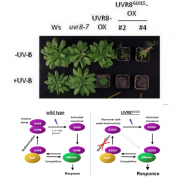
A constitutively monomeric UVR8 photoreceptor allele confers enhanced UV-B photomorphogenesis (bioRxiv)
Plant Science Research WeeklyIn response to UV-B light, the plant UV-B photoreceptor UV RESISTANCE LOCUS 8 (UVR8) monomerizes and activates, inducing UV-B acclimation and survival. Re-dimerization by REPRESSOR OF UV-B PHOTOMORPHOGENESIS 1 (RUP1) and RUP2 inactivates UVR8. In order to further clarify UVR8 pathway regulation, Podolec…
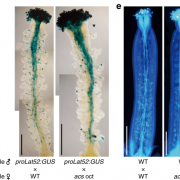
Going my own way: Ethylene-independent ACC signaling in pollen tube attraction (Nature Comms.)
Plant Science Research Weekly1-Aminocyclopropane-1-carboxylic acid (ACC) is the precursor of the phytohormone ethylene. Here, Mou and co-workers show ACC to act independent of ethylene in the ovule to attract growing pollen tubes. Mutants impaired in ACC biosynthesis had less fertilization and seed setting events. Fertilization…
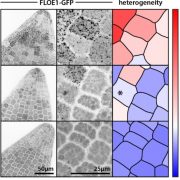
Hydration-dependent phase separation of a prion-like protein regulates seed germination during water stress (bioRxiv)
Plant Science Research WeeklyPlant seeds can remain dormant for several years under stress conditions and subsequently germinate once favorable conditions return. Even though this phenomenon has been known for many years, what keeps the seed from germinating during the unfavorable conditions, especially during water deficit conditions,…

From one cell to many: Morphogenetic field of lateral root founder cells in Arabidopsis is built by gradual recruitment (PNAS)
Plant Science Research WeeklyBecause plant cells don’t usually move within an organ, it is possible to trace the developmental program cell by cell, through a technique called clonal analysis. If a single cell can be labeled in some heritable way, then all its progeny will also carry this label. Torres-Martínez et al. randomly…
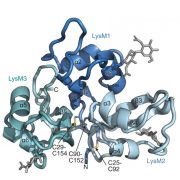
Friend vs. foe: molecular insight towards microbial recognition and specificity in legume signaling (Science)
Plant Science Research WeeklyEcosystems are founded by relationships between organisms, such as the mutualism between plants and microbes. An example is the agriculturally important symbiosis between legumes and nitrogen-fixing bacteria that reside in nodules of legumes. Legumes must be able to differentiate, through undetermined…

Plant Science Research Weekly: August 21, 2020
WWR Full PostStimulating photosynthetic processes increases productivity and water-use efficiency in the field …
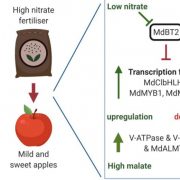
Sweet or Sour? Important Link between Nitrate Signalling and Malate Accumulation Identified in Apple
Blog, Plant Physiology, Plant Physiology: News and Views, ResearchAuthor: Stefanie Wege
[email protected]
ORCID: 0000-0002-7232-5889
Affiliation: ARC Centre of Excellence in Plant Energy Biology, Plant Research Centre,
School of Agriculture, Food and Wine, Waite Research Institute, University of Adelaide, Waite Campus, Glen Osmond 5064, South…

Membrane tethering proteins cooperate in lipid droplet formation
Blog, Research, The Plant Cell, The Plant Cell: In a NutshellGreer et al. explore the role of SEIPIN in packaging oils into lipid droplets.
Plant Cell https://doi.org/10.1105/tpc.19.00771
By Yingqi Cai, Brookhaven National Laboratory, Department of Biology, Upton, NY 11973
Kent D. Chapman, University of North Texas, BioDiscovery Institute, Denton, TX…

To grow or defend? More on the plant cornelian dilemma
Blog, Plant Physiology, Plant Physiology: News and Views, ResearchAuthor
Anne-Sophie Fiorucci
[email protected]
Affiliation
Centre for Integrative Genomics, Faculty of Biology and Medicine, Génopode Building, University of Lausanne, CH-1015 Lausanne, Switzerland.
ORCID number
0000-0002-3254-5967
Growth and defense are usually opposed…

